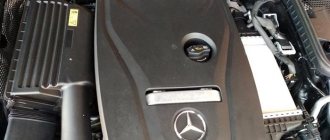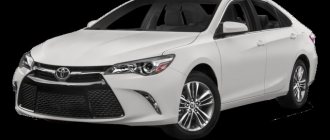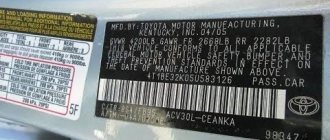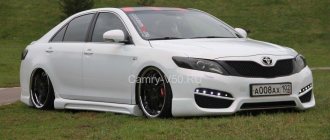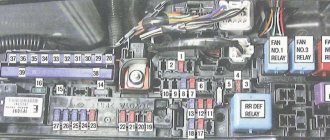Toyota Camry cars of the 2002 model year with left or right-hand controls belong to the XV30 generation. The cars were assembled at factories in Japan, the USA and Australia. Some sedans were sold through official Toyota dealers operating in large cities of the Russian Federation, but the bulk were imported from abroad in used form.
The car is a 2002 Toyota Camry.
Description of the Toyota Camry 2002 car
The new generation XV30 received an improved body with programmable deformation zones, which increased safety in collisions. The cars were offered to customers only with a 4-door sedan body.
The cars were distinguished by increased comfort and an expanded package of options not available for the previous generation XV20. An additional advantage was the exhaust gas system with a neutralizer - this made it possible to reduce toxicity to the requirements of the European Euro-3 standard.
The car was based on a new platform with an independent lever suspension. The increased distance between the axles and the widened track increased the vehicle's stability when driving at high speeds.
The chassis used MacPherson struts, which ensured a smooth ride when driving on dirt roads. The softness of the chassis did not allow sharp maneuvers and increased the risk of body swaying on transverse waves of the road surface.
Appearance
Sedans for the 2002 model year received a massive front bumper and elongated headlights with integrated turn indicators. The protruding edges of the wheel arches were connected by a belt line, and protective rubber pads were retained on the doors.
Thanks to the streamlined shape, the drag coefficient has decreased, and there is much less noise when moving at high speed. The stern lighting equipment with increased dimensions has improved the visibility of the lights at night.
Appearance of the car.
Advantages
Advantages of Camry XV30 generation:
- spacious interior;
- wide luggage compartment with the ability to increase useful volume by folding the back of the rear sofa;
- good noise protection;
- high wear resistance of finishing materials;
- wide view from the driver's seat;
- soft chassis that does not transmit vibrations from small irregularities on the road.
Specifications
Camry sedans were offered in 2002 in 7 color options (white paint was not included in the production program). The base model with a 2.4-liter power unit was equipped with a gearbox with 5 forward speeds and manual shift.
The majority of the vehicles used a hydraulic 4-speed transmission, which was highly reliable.
Front-wheel drive was the standard for foreign markets, but the Four modification with a 4x4 transmission (the rear wheel drive had a viscous coupling) became popular in Japan.
Main settings
Specifications:
- curb weight - from 1470 to 1550 kg;
- permissible total weight - from 1935 to 2015 kg;
- Tank capacity - 70 l.
Engine
The following engines were used on the machines:
- the basic 2AZ-FE, which had a 4-cylinder in-line block with a volume of 2.4 liters and a 16-valve head with a system for adjusting the timing of the mixture intake and exhaust gas emissions VVT-i;
- improved 1MZ-FE with a V-shaped arrangement of 6 cylinders with a volume of 3.0 liters and separate 12-valve heads for each block.
Motor 2AZ-FE.
Power, acceleration and speed
The main engine parameters and dynamic capabilities are presented in the table.
| Motor model and gearbox type | Power, l. With. | Torque, N.m | Acceleration time to 100 km/h, seconds | Maximum speed, km/h |
| 2AZ-FE manual transmission | 149 | 218 | 210 | 9,4 |
| 2AZ-FE automatic transmission | 149 | 218 | 200 | 10,5 |
| 1MZ-FE automatic transmission | 183 | 273 | 225 | 9,1 |
Machine dimensions
Dimensions of a 2002 Camry:
- body length - 4805 mm;
- width - 1795 mm (excluding rear view mirrors);
- height - 1470 or 1480 mm (depending on the type of wheels);
- ground clearance - 150 mm;
- base - 2720 mm.
Machine design
Design concept of Toyota Camry 2002. continues to keep up with the times. It exudes a modern identity that is harmoniously combined with an unshakable sophistication that fits the description of representatives of the business segment.
The front part of the car remains unique and characteristic only of Camry. Cast bumpers, a radiator grille with chrome, and a non-standard headlight shape created an individual, recognizable style for the car. The back is also original. Unusually large, but harmoniously merging with the body taillights, combined with the overall mass of the rear bumper - all this together created a unique sedan, for which it became loved by millions of car owners.
Toyota Camry 2002. everything is fine with aerodynamics. Her appearance speaks to this. An air resistance coefficient of 0.28 indicates excellent acceleration and fuel consumption.
Car equipment
Cars for the 2002 model year were offered in several versions (LE, SE and XLE). The set of options depended on the original sales market; cars for Japan were distinguished by improved equipment.
For example, the factory installed a rectangular sunroof with an electric drive; on expensive models, a navigation system with a color display and voice informant was offered.
Comfort-enhancing devices
Standard equipment included:
- hydraulic power steering;
- on-board computer with display in the instrument cluster;
- 4 loudspeakers (the rear speakers were located on a shelf under glass);
- column with manual adjustment for reach and angle;
- electric drives of side windows with the possibility of locking by the driver;
- electric heating and adjustment of rear-view mirrors;
- heating and air conditioning system with automatic adjustment;
- 2 Din radio with tuner, 4-channel amplifier and CD player;
- electrically heated front seats with separate adjustment;
- rain and light sensors (for automatic control of windshield wipers and side lighting);
- rear seat back with folding mechanism.
The basic version had fabric upholstery and door trim, and the front seats were manually adjustable. When ordering leather trim, power drives for the driver and passenger seats were offered. Regardless of the level of equipment, there were linings with imitation wood veneer on the central tunnel and door panels.
Car dashboard.
For safety
The basic set of security systems included:
- power bars in the doors, absorbing some of the energy upon impact and increasing rigidity;
- spars with programmable deformation;
- inertial seat belts (front with pyrotechnic tensioners);
- safety front head restraints;
- 4 airbags (front and side in the back of the seats);
- electronic immobilizer with identifier in the key head;
- ABS unit with electronic brake force distribution and pressure increase system during emergency speed reduction;
- central locking with the ability to lock doors from the driver's seat;
- safety switches in the rear doors (to protect against accidental unlocking by children while driving);
- head fog lights;
- aft fog light and an additional speed reduction signal under the rear window.
All models used disc brakes. The version with a 3-liter engine offered a trajectory stabilization system integrated into the ABS unit.
At the same time, a controller was installed to prevent the drive wheels from slipping. The driver could forcefully turn off the system by pressing a button.
Airbags in cars.
Other equipment
By default, the cars were equipped with protective mudguards at the front and rear, and a full-size spare tire was stored under the decorative floor of the luggage compartment.
The kit included a jack and a wrench for removing and installing the disc from the hub.
On the inside of the hood there was a screen made of elastic material that reduced noise levels. Toyota dealers installed mechanical or electronic anti-theft systems at the buyer's request.
Features of operation
During the operation of cars with mileage of more than 300 thousand km, the driver will encounter breakdowns of the main components of the power plant and chassis.
The interior trim will require attention; surface and through corrosion may appear on the body. For repairs, you can use spare parts from alternative manufacturers or purchase components from broken cars.
The 2002 Toyota Camry with a mileage of more than 300 thousand km has its parts worn out.
What problems might you encounter?
Common car faults:
- squeaking brakes and premature wear of mechanism parts due to jamming of guides;
- Damage to the threads of the timing cover studs due to incorrect tightening torque;
- squeaks in the suspension while driving indicate destruction of the arm joints;
- a crunching sound when turning the steering wheel with biting occurs when the shaft cross is worn;
- jerks when accelerating under load are explained by a breakdown of the air flow sensor;
- The turning on of the Check Engine indicator and the appearance of error P1135 indicate a failure of the heating system of the oxygen concentration sensor;
- poor road lighting due to improper adjustment;
- increased oil consumption with the appearance of smoky exhaust due to wear of the piston group or valve stem seals;
- unpleasant odor in the cabin when the air conditioner is turned on due to a dirty evaporator;
- jerks when changing gears occur when the oil level is insufficient or due to wear of the clutches;
- vibrations of the body when the engine is running indicate failure of the supports;
- poor starting of a heated engine is associated with clogged or leaking injectors (at the same time the Check Engine indicator turns on);
- Crunching or clicking noises when turning indicate a broken constant velocity joint.
Owner reviews
Mikhail, 36 years old, Moscow
In 2006, I bought a Camry sedan, imported from Europe. The car was assembled at the beginning of 2002 and drove 150 thousand km. The salon surprised me with its size and quality of materials.
The power of the 149-horsepower engine was enough for the city and the highway, fuel consumption ranged from 8 to 12 liters. I sold the car after 3 years, during my ownership I only changed the oil and filters. For its time it was an excellent car with good sound insulation.
Ruslan, 40 years old, Nizhny Novgorod
I was looking for a large car at a minimal price; I didn’t consider Russian Volgas. An acquaintance offered to buy a Camry sedan made in 2002 with a 3-liter engine; the car required body and suspension repairs.
After registration, restoration work began, which took more than 10 months. In addition to the sills, we had to install new fenders and a hood.
I rarely use the car; I consider the disadvantages to be high gasoline consumption (at least 10 liters per 100 km) and difficulties in purchasing original spare parts.
Body
The Japanese is known as a sedan, but some markets were filled with Gracia station wagons, and in 2000 the Solara coupe arrived. The style is classic 90's JDM. There are no memorable unique elements here, something that Toyota and Camry have never been famous for.
The design of the European and American versions is different. The main difference is 17-inch wheels versus 15-inch in Europe. Everything else is trifles.
The design is aerodynamic, but also reliable. Corrosion rarely gets to the metal, especially if the owner takes care of the condition. Of course, after so many years it is more difficult to fight rust, and the 6-year warranty has long expired. It is recommended to look for the latest years of production, since these machines received full double-sided galvanization, versus partial before 200.
Sedan dimensions:
- length – 4760 mm;
- width – 1781 mm;
- height – 1430 mm;
- wheelbase – 2670 mm;
- ground clearance - 145 mm.
Similar cars
Competitors for used Camry XV30 cars are Audi A6, Ford Mondeo, Volkswagen Passat or Skoda Superb sedans, produced in 2002-2004.
All cars have mileage of more than 300 thousand km and have changed 5-6 owners in the Russian Federation. During operation, the owner will encounter natural wear and tear of the main components and body defects.
Toyota's competitors are Audi A6 and Ford Mondeo.
Running equipment
At that time, the extremely innovative VVT-i technology began to be installed in the engines of fifth-generation cars. The essence of this mechanism was a system for changing valve timing, which was installed in car engines up to the 2005 Toyota Camry. The system adjusted engine operation to the driver’s driving style and produced maximum efficiency.
Top version of Toyota Camry 2005. It was powered by a 3.5 liter V-6 engine, which produced 186 “horses” at 5.3 thousand rpm. At the same time, the car reached a hundred in 9 seconds. The “Japanese” was equipped with a new “automatic” Super ECT, which provided fast and smooth switching due to electronic control.
Another power unit option is 2.4 liters. It was equipped with a padidiapazonny “mechanics” or the same “automatic” Super ECT. With such an engine, at 5.6 thousand rpm, the car developed a power of 152 hp. With.
